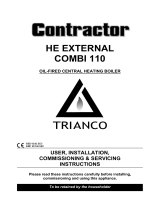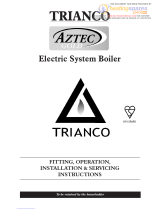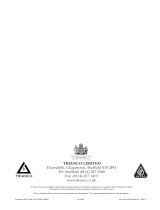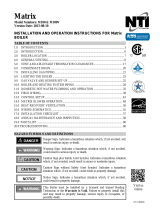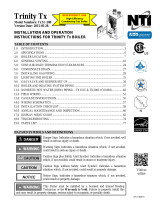Page is loading ...

INSTALLATION AND OPERATING
INSTRUCTIONS
TRO EVOLUTION COMBI
OUTDOOR

page -2
Index
1.- PRESENTATION...............................................................................................................................................................................................................4
2.- DESCRIPTION OF COMPONENTS........................................................................................................................................................................5
3.- CONTROL ELEMENTS..................................................................................................................................................................................................6
4.- INSTALLATION INSTRUCTIONS................................................................................................................................................................................7
4.1 LOCATION ...........................................................................................................................................................................................................................7
4.2 HYDRAULIC INSTALLATION ...............................................................................................................................................................................................7
4.3 CONDENSATION PIPE........................................................................................................................................................................................................8
4.4 ELECTRICAL CONNECTION..............................................................................................................................................................................................8
4.5 OIL INSTALLATION ..............................................................................................................................................................................................................8
4.6 COMBUSTION PRODUCTS EXHAUSTION.........................................................................................................................................................................9
4.7 DRAINING THE BOILER.....................................................................................................................................................................................................10
4.8 PRECAUTIONS FOR PREVENTING NOISE DURING OPERATION.................................................................................................................................10
4.9 INSTALACIÓN DEL CIRCUITO DE CALEFACCIÓN Nº 2 (OPCIONAL)....................................................................................................................10
4.10 FILLING AND BLEEDING THE INSTALLATION...............................................................................................................................................................11
5.- COMBUSTION PRODUCT REMOVAL ..............................................................................................................................................................12
5.1 HORIZONTAL COMBUSTION PRODUCT REMOVAL.....................................................................................................................................................12
5.2 VERTICAL COMBUSTION PRODUCT REMOVAL ...........................................................................................................................................................14
6.- PIPE CONNECTIONS.................................................................................................................................................................................................15
7.- DISPLAY DIGITAL.........................................................................................................................................................................................................17
8.- TEMPERATURE ADJUSTMENT................................................................................................................................................................................17
8.1 ADJUSTING THE BOILER SET-POINT TEMPERATURE ......................................................................................................................................................17
8.2 ADJUSTING THE DHW SET-POINT TEMPERATURE........................................................................................................................................................17
9.- OPERATION ...................................................................................................................................................................................................................18
10.- HEATING CIRCUIT 2 OPERATION (OPTIONAL)........................................................................................................................................18
11.- ADDITIONAL FUNCTIONS....................................................................................................................................................................................19
11.1 PUMPS ANTI-BLOCK FUNCTION ..................................................................................................................................................................................19
11.2 BOILER ANTI-FREEZING FUNCTION..............................................................................................................................................................................19
11.3 ROOM THERMOSTAT CONNECTION...........................................................................................................................................................................19
12.- OPERATION WITH TIMER (OPTIONAL)..........................................................................................................................................................19
13.- E20 REMOTE CONTROL (OPTIONAL)...........................................................................................................................................................19
13.1 FUNCTIONING WITHOUT AN OUTDOOR SENSOR.....................................................................................................................................................20
13.2 FUNCTIONING WITH AN EXTERNAL SENSOR (OPTIONAL)......................................................................................................................................20
13.3 DHW MODE OPERATION ............................................................................................................................................................................................20
13.4 TELEPHONE RELAY FUNCTION......................................................................................................................................................................................20
14.- SHUTTING DOWN THE BOILER...........................................................................................................................................................................21
15.- SAFETY CUT-OUTS ....................................................................................................................................................................................................21
15.1 TEMPERATURE SAFETY LOCKING .................................................................................................................................................................................21
15.2 BURNER LOCKING .........................................................................................................................................................................................................21
15.3 LOW PRESSURE CUT-OUT..............................................................................................................................................................................................21
16.- FIRST START-UP ...........................................................................................................................................................................................................21
17.- DELIVERY OF THE SYSTEM ...................................................................................................................................................................................22
18.- BOILER MAINTENANCE........................................................................................................................................................................................22
18.1 CLEANING THE BOILER .................................................................................................................................................................................................22
18.2 CLEANING THE BOILER BODY......................................................................................................................................................................................22
18.3 CLEANING THE CONDENSER.......................................................................................................................................................................................23
18.4 BOILER WATER CHARACTERISTICS ..............................................................................................................................................................................23
18.5 ANTI-FROST PROTECTION.............................................................................................................................................................................................24
18.6 CONDENSATE DRAIN-OFF ...........................................................................................................................................................................................24
19.- CIRCULATING PUMPS FLOW CURVES.........................................................................................................................................................24
19.1 CHARACTERISTIC CURVES OF THE PUMP ..................................................................................................................................................................25
19.2 REGULATION OF THE CIRCULATION PUMP................................................................................................................................................................25
19.3 PRESSURE DROP .............................................................................................................................................................................................................25
20.- TECHNICAL DATA....................................................................................................................................................................................................26
21.- ELECTRICAL DIAGRAM........................................................................................................................................................................................27
22.- ELECTRICAL CONNECTION DIAGRAM ......................................................................................................................................................28
23.- DIAGRAMS AND MEASUREMENTS................................................................................................................................................................29
24.- BURNER..........................................................................................................................................................................................................................30

page -3
24.1 ASSEMBLY........................................................................................................................................................................................................................30
24.2 BURNER START-UP ..........................................................................................................................................................................................................30
24.3 ADJUSTING THE COMBUSTION CONDITIONS............................................................................................................................................................30
24.4 PRIMARY AIR ADJUSTMENT ..........................................................................................................................................................................................31
24.5 COMBUSTION LINE ADJUSTMENT................................................................................................................................................................................31
24.6 CORRECT POSITION OF ELECTRODES........................................................................................................................................................................32
24.7 OIL PRESSURE ADJUSTMENT .........................................................................................................................................................................................32
24.8 PIPE OPERATION ............................................................................................................................................................................................................32
24.9 OIL SUPPLY PIPING DIAGRAMS...................................................................................................................................................................................33
24.10 TECHNICAL SPECIFICATIONS ....................................................................................................................................................................................33
24.11 OPERATING CURVES ..................................................................................................................................................................................................34
24.12 RECOMMENDED NOZZLE AND PUMP PRESSURE ...................................................................................................................................................34
24.13 OIL FLOW VERSUS NOZZLE AND PUMP PRESSURE .................................................................................................................................................34
24.14 ELECTRICAL CONNECTION DIAGRAM....................................................................................................................................................................35
24.15 QUICK CONNECTOR..................................................................................................................................................................................................35
24.16 BURNER CONTROL OPERATING SEQUENCE...........................................................................................................................................................36
25.- FAILURES .......................................................................................................................................................................................................................37
25.1 BURNER ERROR CODE ..................................................................................................................................................................................................37
25.2 BOILER FAILURES:...........................................................................................................................................................................................................37
25.3 CIRCULATING PUMP ALARMS .....................................................................................................................................................................................38
26.- ALARM CODES.........................................................................................................................................................................................................39
27.- SPARE PARTS LIST.....................................................................................................................................................................................................40
BURNER ......................................................................................................................................................................................................................................40
BOILER........................................................................................................................................................................................................................................41
ELECTRIC BOARD.....................................................................................................................................................................................................................42

page -4
1.- PRESENTATION
Thank you for choosing a TRIANCO heating boiler. You have chosen a boiler that, with a
suitable hydraulic installation and using oil for fuel, will provide the ideal level of comfort for
your home.
This manual forms an essential part of the product and it must be given to the user. Read the
warnings and recommendations in the manual carefully, as they contain important
information on the safety, use and maintenance of the installation.
These boilers must be installed by qualified personnel only, in accordance with the legislation
in force and following the manufacturer's instructions.
The start-up of these boilers and any maintenance operations must only be carried out by
Official Technical Assistance Services of TRIANCO.
Incorrect installation of these boilers could result in damage to people, animals or property,
and the manufacturer will hold no liability in such cases.
TRIANCO informs all parties concerned that, in compliance with section 1 of the first
additional provision of Law 11/1997, the responsibility for delivering packaging waste or used
packaging for its proper environmental management will be that of the final owner of the
product (Article 18.1 Royal Decree 782/1998). At the end of its useful life, the product must be
taken to a selected collection point for electrical and electronic equipment or must be
returned to the distributor at the time of purchasing a new equivalent appliance. For more
detailed information on the collection schemes available, contact either the collection
facilities of the local authority or the distributor where the purchase was made.

page -5
2.- DESCRIPTION OF COMPONENTS
1
2
3
4
5
6
7
8
9
10
11
12 13 14
10
15
16
17
1. Blow off valve.
2. Filling valve.
3. DHW temperature sensor
4. Balance flue burner.
5. DHW exchanger.
6. Heating pump.
7. DHW pump.
8. Boiler temperature sensors.
9. Safety valve.
10. Automatic air vent.
11. Pressure sensor.
12. Expansion vessel.
13. Condensator INOX.
14. Flue gases outlet.
15. Cast iron corp.
16. DHW flow switch.
17. DHW flow limiter.

page -6
3.- CONTROL ELEMENTS
Pressure gauge (18):
It indicates the installation pressure.
Digital display (19):
This display lets us view the different temperatures of the system as well as the functions and
error codes that are activated by the electronic control of the boiler.
Adjusting the boiler temperature (20):
You will be able to, by means of this element, select the heating working temperature, stopping
the burner when the boiler temperature reaches that selected or keeping it running as long as
the temperature is lower than that pre-set.
Adjusting the DHW temperature (21):
It allows us to select the operating temperature of the domestic hot water.
Main selector (22):
It allows the boiler to be switched on and off by pushing "O/I" button. You can select the
summer position "☼" (only DHW) or winter position "" (DHW + Heating).
Blocked due to temperature pilot light (23):
When lit, it indicates that the boiler operation has been blocked due to excessive temperature
(higher than 110ºC).
Safety thermostat (24):
It ensures that the boiler temperature does not exceed 110 ºC by locking its operation.
Pilot Summer (25):
When lit, it indicates that the service is selected
Summer (DHW only).
Pilot Winter (26):
When lit, it indicates that the service is selected
Winter (heating + DHW).

page -7
4.- INSTALLATION INSTRUCTIONS
This boiler is suitable for heating water to a temperature below boiling point at atmospheric
pressure. It must be connected to a heating installation and/or a domestic hot water
distribution network, which must always be compatible with its performance and power.
This appliance must only be used for the purpose for which it has been expressly designed. Any
other use is considered unsuitable and therefore hazardous. The manufacturer shall not be
considered liable under any circumstances for damage caused by unsuitable, erroneous or
irrational use.
Remove all the packaging and check the contents are complete. In case of doubt, do not use
the boiler. Contact your supplier. Keep the packaging elements out of reach of children, as
they can be dangerous.
When you no longer wish to use the boiler, disable the parts that could represent a potential
hazard.
The boiler must be installed by personnel authorised in accordance with the applicable
regulations and standards in force. However, the following recommendations must be
complied with when installing the boiler:
4.1 Location
The TRO Evolution Combi Outdoor boiler must be installed taking into account the following
guidelines:
- It must be placed on a solid, level base which can bear the weight of the boiler, even
when it is full of water.
- It can be installed either against a building or in an open area at a distance from the
building.
- The relevant instructions must be followed for the correct installation of the flue outlet.
- Maintain the minimum distances from any obstacle which may hinder the access to
the components and maintenance operations.
- The boiler must be positioned in such a way that does not obstruct the air inlets.
4.2 Hydraulic Installation
The hydraulic installation must be made by qualified personnel. The applicable installation
legislation is to be complied with, and the following recommendations should also be taken
into account:
- The inside of the installation piping should be thoroughly cleaned before switching on
the boiler.
- We recommend inserting cut-off valves between the installation piping and the boiler
to simplify maintenance tasks.
- Fill the siphon with water before starting up the unit, to prevent fumes coming out of it.

page -8
- The condensation pipe should lead to a drain outlet, as the Evolution boiler is a
condensation boiler and a large amount of water may be generated. This connection
should be made in accordance with the regulations for draining off condensation
water to the drain network.
- Drain valves and suitable devices for correctly bleeding the air from the circuit during
the boiler filling stage should be fitted.
- Install all the necessary safety elements (expansion vessel, safety valve, etc.) to comply
with the applicable regulations for the installation.
- The TRO Evolution Combi Outdoor is equipped with a standard 14 litre closed expansion
vessel. Depending on the total volume of the hydraulic circuit, it may be necessary to
install an additional expansion vessel consistent with this volume.
WARNING: In order to avoid damage to the boiler, antifreeze fluid must be added to the
water of the heating circuit. If the boiler is to be out of use for long periods of time, we
recommend draining all the water and leaving it empty.
4.3 Condensation pipe
The condensation pipe should lead to a drain outlet, as the TRO Evolution Combi Outdoor
boiler is a condensation boiler and a large amount of water may be generated. This
connection should be made in accordance with the regulations for draining off
condensation water to the drain network and the following recommendations must be
complied:
- The length of the pipes should be as short as possible. The sections external to the
boiler should not exceed 3 m so as to reduce the risk of freezing.
- They must have a minimum inclination to the outside of 3º from the boiler.
- The diameter of the external pipe of the boiler should be greater than 30mm so as to
reduce the risk of freezing.
- The condensation drainage pipe must be resistant to the acids of the condensation
agents. Plastic materials used in water drainage are suitable, whereas copper or steel
piping should not be used.
4.4 Electrical Connection
The boiler is equipped for connection at 230 V~, 50 Hz to terminals 1 and 2 of terminal strip J1
(see Electrical Connection Diagram). Remember to earth the appliance.
The boiler has two terminal strips, TA1 (J5) and TA2 (J7) for connecting room thermostats or
room chronothermostats (see “Electrical Connection Diagram”) for remote control of
heating circuits 1 and 2 respectively. To correctly connect the room thermostats, firstly
remove the bridge joining the terminals of terminal strip TA1. For connection to TA2, simply
connect the thermostat to the terminal strip.
4.5 Oil installation
The TRO Evolution Combi Outdoor boiler is supplied with a Domestic gas-oil burner (see model
in Technical Characteristics). To install the oil line, proceed in accordance with the burner
instructions enclosed with this manual (see Burner section). The oil line installation and start-up
of the burner must be carried out by qualified, authorised personnel.

page -9
4.6 Combustion products exhaustion
The installation of exhaustion of the products of combustion has to be carried out by
qualified personnel staff and it will fulfill the requirements demanded in the legislation and
effective regulatory schemes.
The TRO Evolution Combi Outdoor boilers are oil-fired boilers, and the combustion products
are therefore removed through an outlet pipe. It is recommended that the position of the
outside exhaust duct is as shown in the figures and in the table below:
Terminal position Balanced
horizontal flue
mm
A Directly below an opening, air brick, opening window etc. 600
B Horizontally to an opening, air brick, opening window etc. 600
C Below a gutter, eaves or balcony with protection 75
D Below a gutter or balcony without protection 600
E From vertical sanitary pipework 300
F From an external or internal corner or surface or boundary alongside a
terminal 300
G Above ground or balcony level 300
H From a surface or boundary facing terminal 600
J From a terminal facing a terminal 1200
K Vertically from terminal on the same wall 1500
L Horizontally from terminal on the same wall 750
Besides this figures and the table above the following recommendations must be complied
with when installing the boiler:
- Terminals should be positioned to avoid products of combustion accumulating in
stagnant pockets around the building, or entering into buildings.

page -10
- If the lowest part of the terminal is less than 2m above the ground, balcony, flat roof
or other place to which any person has access, the terminal must be protected by a
stainless steel guard.
- Notwithstanding the dimensions given in the diagram and table, a terminal should
not be sited closer then 300mm to combustible material.
- Flue gases have a tendency to plume and in certain weather conditions a white
plume of condensation will be discharged from the flue outlet which could be
regarded as a nuisance, for example, near security lighting.
- There should be no restriction preventing the clearance of combustion products
from the terminal.
- Where a flue is terminated less than 600mm away from a projection above it and
the projection consists of plastic or has a combustible or painted surface, then a
heat shield of at least 750mm wide should be fitted to protect these surfaces.
NOTE: All accessories used for combustion product removal and air intake should be those
supplied by TRIANCO.
4.7 Draining the boiler
The boiler is emptied by opening the drain tap located in the rear of the boiler. A flexible
hose must be attached to this tap to direct it to a water outlet. After draining the boiler, the
valve must be closed and the flexible tube removed.
4.8 Precautions for preventing noise during operation
Ensure the flow and return pipes are not touching each other, or insulate them to prevent
any vibration noise. The boiler must be correctly seated on its base and levelled. Before start-
up, make sure that the boiler and the system have been properly bled.
4.9 Instalación del circuito de calefacción Nº 2 (Opcional)
All the models in the TRO Evolution Combi Outdoor range of boilers are supplied with a
circulation pump connected to heating circuit 1 (BC1). In addition to this circuit, all the
models are designed to control a second heating circulation pump in a second heating
circuit (circuit 2, BC2).
The hydraulic installation of heating circuit 2 should be made using the optional flow circuit
on the rear of the boiler (see "Diagrams and Measurements").
The circulation pump installed in heating circuit 2 must be electrically connected between
terminals N and 6 on the supply connector block J2 (see "Connection Diagram").

page -11
Optional flow
circuit
4.10 Filling and bleeding the installation
To fill the installation, open the fill valve until the manometer shows a pressure of 1 - 1.5 bars.
The circuit should be filled slowly and with the automatic air bleed valve cap loose, to let the
air out of the installation. The air should also be bled from the rest of the installation using the
air bleed valves provided. Close the fill valve after filling.
CAUTION: Switching on the boiler with no water inside could result in serious damage.

page -12
5.- COMBUSTION PRODUCT REMOVAL
The combustion product exhaust ducts must be installed by qualified personnel and must
comply with current legislation and standards.
The maximum length of pipe that can be installed is 12 metres (TRO Evolution 40 Combi
Outdoor) and 15 metres (TRO Evolution 30 Combi Outdoor). Each elbow of 90°, or two of 45°,
reduces the available length by 1 metre, and 1 metre of horizontal pipe represents 2 metres of
vertical pipe.
It is recommended that the flue gases outlet pipe be fitted slightly upwardly-inclined 2º to 3º
thus preventing water and condensate projections from being ejected outside.
CAUTION: The air intake holes provided in the upper part of the door must not be obstructed at
any time.
5.1 Horizontal combustion product removal
The TRO Evolution Combi Outdoor boiler comes equipped with a 45º horizontal outlet terminal
which can be placed on each of the sides or on the back of the boiler for removing fumes.
RIGHT
EXIT LEFT
EXIT
REAR
EXIT

page -13
The steps for correctly modifying the position of the flue outlet are listed below:
NOTE: Fit the pipe with a slight upwards incline of around 2º - 3º, to prevent any water or
condensation from dripping out.

page -14
5.2 Vertical combustion product removal
The combustion products exhaustion can be carried out through vertical pipe of Ø100 mm.
CAUTION: The flue terminal must not be conducted to the wall to avoid condensates.

page -15
6.- PIPE CONNECTIONS
The heating and hot water outlet and inlet of the TRO Evolution Combi Outdoor boiler can be
conducted optionally for either side of the boiler, through the pre-cut openings provided (see
"Diagrams and Measurements"), when the boiler is instaleed against the building (see pictures
Nº4a and 4c). For “free standing” installations the pipework can be conducted trough the pre-
cut openings provided in the base of the enclosure (See picture Nº4b). In this way the boiler
can adapt to installations site needs. The boiler is equipped with ¾” female connections for the
heating outlet and return. For the hot water the boiler is equipped with ½” female connections.
The boiler is equipped with different removal panels on the rear, sides and top to gain access to
the water connection, condensate pipe, components and do maintenance (see picture Nº2).
Withdraw them removing carefully the stainless screws.
The pressure valve should run downwards away from the boiler by at least 15 mm diameter
copper pipe (see pictures Nº5). It should discharge away, through one of the openings
provided at the side of the enclosure, and terminate avoiding any electrical or other hazard.
The steps for correctly connecting the heating outlet and return, safety valve discharge tube
and hot water are listed below:

page -16

page -17
7.- DISPLAY DIGITAL
The boiler TRO Evolution Combi Outdoor is electronic and incorporates a digital display (19) for
the visualization of those actual temperatures and the set point temperatures. Pressing the
button SET located under the display, it will be able to navigate per rest of the available
visualization options, according to the following instructions:
ºC
set
Visualization display
Navigation button
Pressing the button of SET successively will select the different options to visualize. Once
selected desired option, lapsed three seconds, it will return to the stand by condition.
In the following table the different options of visualization of the display are described:
T 1
Actual temperature of the boiler.
T2 Actual DHW temperature.
TC
Boiler set point temperature, selected with the boiler temperature
selector button (20).
A(
DHW set point temperature, selected with the DHW temperature
selector button (21).
UB
Circulation pump speed
8.- TEMPERATURE ADJUSTMENT
8.1 Adjusting the boiler set-point temperature
To set the desired operating temperature for the boiler,
select "tc" on the screen using the browser button on the
display. After three seconds, the current set-point
temperature will be displayed. To change the set-point,
turn the boiler temperature adjustment control on the
control panel (12) until the new set-point temperature you
wish to set is displayed.
8.2 Adjusting the DHW set-point temperature
To set the desired service temperature for the DHW, select
"AC" on the screen using the browser button on the
display. After three seconds, the current set-point
temperature will be displayed. To change the set-point,
turn the DHW temperature adjustment control on the
control panel (13) until the new set-point temperature you
wish to set is displayed.
ºC
set
TC
ºC
set
A(

page -18
9.- OPERATION
The TRO Evolution Combi Outdoor boiler is factory set to heat a heating installation and provide
instant domestic hot water.
We can distinguish between two standard operating modes:
Winter position ""
In this position, the boiler can simultaneously heat up the heating installation and domestic
hot water. To select this position, set the general selector to "" position. The burner will switch
on. When the boiler reaches 60ºC it is ready to heat up the heating installation and will start
up the heating pump for this purpose. The burner will shut down when the boiler reaches its
selected set-point temperature. The heating pump and the burner will stop when the room
temperature reaches or exceeds the temperature set on the installation's room thermostat (if
it has one). If a hot tap is turned on, the instantaneous DHW production system will start up
and provide constant domestic hot water at the selected DHW set-point temperature.
Summer position "☼"
In this position, the boiler only supplies domestic hot water. To select this position, set the
general selector to "☼". The burner will ignite until the boiler reaches 60ºC. If a hot tap is
turned on, the instantaneous DHW production system will start up and provide constant
domestic hot water at the selected DHW set-point temperature.
The TRO Evolution Combi Outdoor boiler is equipped with a system for modulating instant DHW
production and progressive adjustment of the Domestic Hot Water consumption temperature:
The modulation allows the boiler power to constantly adapt to the DHW consumption
requirements at all times, without altering the efficiency of the boiler. Consumption
savings are thus obtained together with improved boiler functioning and lower
emissions.
Progressive electronic adjustment of the DHW temperature, a system designed by
TRIANCO, enables the DHW consumption temperature to be stabilised at the
temperature selected using the button on the control panel and a constant hot water
temperature with no variations is obtained regardless of the water flow required or the
cold water inlet temperature at any given time. This enables optimum hot water
comfort and adaptation to each user's particular needs.
10.- HEATING CIRCUIT 2 OPERATION (OPTIONAL)
All the models in the TRO Evolution Combi Outdoor range of boilers have the option of
controlling a second heating circuit. This requires the installation of a second circulation pump
in the boiler. To correctly install this pump, carefully follow the instructions given in the "Installing
heating circuit 2" section of this manual.
Heating circuit No. 2 will work at the selected boiler set point temperature "tc" and at the
temperature of room thermostat No. 2 (TA2) (if the boiler has one). The burner and the heating
pump of circuit 2 (BC2) will begin to function until the installation reaches the selected boiler
set-point temperature or the temperature of room thermostat No. 2, (if the unit has one). When
the temperature of the installation drops below the selected boiler temperature, the burner will
start up again, running the heating cycle.

page -19
11.- ADDITIONAL FUNCTIONS
The boiler TRO Evolution Combi Outdoor is equipped with an electronic control able to regulate
the automatic operation of the boiler in an efficient way and it also includes the following
additional control features:
11.1 Pumps anti-block function
This feature prevents the blocking of the circulation pumps of the boiler, due to prolonged
periods that the pumps don't work. This system will remain enable while the boiler is
connected to the electric network.
11.2 Boiler anti-freezing function
This feature protects the boiler of freezing during the freeze periods. When the temperature
of the boiler decreases up to 6 ºC, it will start the heating circulation pump. If the
temperature of boiler continues descending up to 4 ºC, it will put into operation the burner,
heating the installation. Once enabled this feature, will be active until reaching 8 ºC in the
boiler. This system will remain in alert while the boiler is connected to the electric network.
11.3 Room thermostat connection
The boiler has two terminals, in the terminal strip J5 and J6, prepared for the connection of a
room thermostat or room timer (TA1 y TA2, see Electrical Connection Diagram), which allow
to control the heating service depending on the temperature of home. For its connection, it
should take off the bridge of the terminals J5 and J6, and connect the room thermostat
there.
The installation of a room thermostat will optimize the operation of the installation, adjusting
the operation of the heating to the requirements of home, and obtaining some enhanced
benefits of comfort. Also, if the thermostat allows the programming of the hours of operation
(room timer), it will be able to adjust the heating system schedule to the usage of the
installation.
12.- OPERATION WITH TIMER (OPTIONAL)
The TRO Evolution Combi Outdoor boiler may optionally be supplied with a timer, which can be
fitted to the main control panel. Both the boiler and the timer are equipped with a quick
assembly system, described in the installation and operating instructions enclosed with the
timer.
13.- E20 REMOTE CONTROL (OPTIONAL)
A remote control (E20) can optionally be supplied with the TRO Evolution Combi Outdoor boiler.
This remote control can be used to fully operate the boiler from any room in the home in which
it is installed. The E20 remote control governs the settings of heating circuit 1 and the
installation's domestic hot water production (if applicable).
This remote control allows the hours of home comfort to be programmed for heating circuit 1,
adjusting the installation to the particular requirements of the home by measuring the room

page -20
temperature and consequently adapting the installation temperature. The heating and DHW
set-point temperature desired at any time can be set from the control. It can also be used to
display the various operating parameters of the boiler. It also warns of any functioning
anomalies affecting the boiler.
The E20 remote control may optionally be connected to an external sensor, for measuring the
outside temperature. When this option is installed, the remote control can adjust the home
comfort level (circuit 1) according to the weather conditions at each particular time, optimising
fuel consumption and heating comfort in the home.
The E20 remote control takes over the control of the boiler when it is connected to it. The
various selectable boiler temperatures must be modified using the remote control. It is easy to
install, only requiring 2 wires for communication between the boiler and the E20 control. It is
connected to the boiler by connecting the two wires on terminal strip J4 (see "Electrical
Connection Diagram"). For correct installation and functioning, carefully read the instructions
enclosed with the remote control.
The following sections contain a general explanation of the E20 remote control's different
operating modes and options.
13.1 Functioning without an outdoor sensor
Conventional heating installation (direct circuit)
The maximum temperature for heating circuit 1, the scheduled heating times and the
desired room temperatures can be selected on the remote control. The E20 remote
control will calculate the boiler temperature required at each particular time, depending
on the temperature of the room, and it will activate or disable the heating mode of circuit
1 depending on the heating times and room temperatures programmed.
13.2 Functioning with an external sensor (Optional)
If the E20 remote control is fitted with an outdoor temperature sensor, it can calculate the
heating temperature of heating circuit 1 according to the outside weather conditions at
each particular time, with optimum adjustment of the heating installation conditions for
improved comfort in the home and energy savings.
Conventional heating installation (direct circuit)
The maximum temperature, an operating curve for heating circuit 1 (see instructions
enclosed with the E20 remote control) and the desired heating times and room
temperatures can all be selected on the remote control. The E20 remote control
calculates the required boiler temperature at each particular time, depending on the
temperature inside the home and the outside weather conditions, in accordance with the
operating curve selected (setting HEATSLOPE 1 on the E20), switching the heating on and
off in accordance with the heating times and the room temperatures programmed.
13.3 DHW mode operation
On the TRO Evolution Combi Outdoor boiler, the remote control can be used to select the
DHW set-point temperature and the desired hot water times. The E20 remote control
regulates the instantaneous hot water temperature at each particular time and enables or
disables DHW mode in accordance with the times programmed.
13.4 Telephone relay function
The E20 remote control is designed for connection to an external telephone relay. If a
telephone relay is connected to the E20 remote control, the heating mode of heating circuit
/


